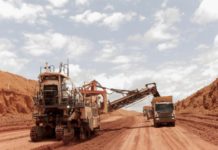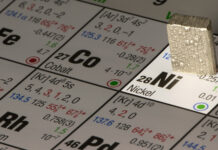
[miningmx.com] — METOREX’S Ruashi mine in the Democratic Republic of Congo (DRC) will produce on average 36,000 tonnes of copper and up to 5,000 tonnes of cobalt a year. This is a far cry from earlier talk of the project being a 45,000 tonnes/year copper project that would also generate 3,500 tonnes of cobalt annually.
New CEO Terence Goodlace ordered a fresh drilling programme and remodelling of the Ruashi mine, where massive project cost-over runs have left the company deep in debt – some R1.9bn by end-September. There were grade discrepancies between what was being mined and what the resource models indicated.
Goodlace told Miningmx the change of 9,000 tonnes in the copper production figure stemmed from constraints in the ore body rather than the plant. The drilling showed head grade of 3.2% copper, down from 3.7%.
“From a plant perspective, if you’ve got the right volumes and grade there’s no doubt you can still achieve 45,000 tonnes,’ he said. “The plant can do the throughput but it’s a function of grade.’
Another positive is the forecast increase in cobalt production, which, when sold, serves as a credit towards copper output and drives down costs. “We’ll certainly be competitive from an overall cost perspective,’ he said. The increased cobalt output stems from the new geological model and fresh assays done on samples.
An important development at Ruashi is the completion of the resource model that has allowed Metorex to draw up a detailed mining and production schedule.
“We can now move forward and build off the current base through completing the production ramp-up and advancing the infill drilling required to bring inferred resources into account,’ Goodlace said in a statement on Wednesday. This helped drive the share price up more than 6% to 324 cents on the JSE.
The current life of mine is 10 years, but this will rise as more drilling is completed and resources are bumped up into higher categories of confidence.
The life of mine shows the mine producing an average of 36,000 tonnes of copper and 4,000 to 5,000 tonnes of cobalt per annum. There is a now a detailed two-year mining schedule up to end-2011.
Chief financial officer Martiz Smith told a results presentation in early September there was a chance of Metorex falling short on a $25m instalment towards Ruashi’s debt in December.
The plant can do the throughput but it’s a function of grade
Goodlace said the sale of Metorex’s 55% stake in the Vergenoeg fluorspar mine for $60m was on track for completion during December 2009. The money will go towards paying down Ruashi debt.
Metorex has embarked on a strategy of selling non-core assets and giving full management attention to making sure Ruashi works.
The Ruashi mine produced 2,512 tonnes of copper and 274 tonnes of cobalt in October, with plant throughput at 90% of capacity. In the September quarter, Ruashi produced 5,690 tonnes of copper and 666 tonnes of cobalt.
Metorex forecast 6,500 tonnes of copper production at Ruashi in the December quarter and 650 tonnes of cobalt.
The cost of production, excluding credits from cobalt, fell to $2,800/tonne of copper produced. In the June quarter the cost was $3,733.
Copper is trading at a spot price of $6,761/tonne. Metorex has hedged 24,750 tonnes of Ruashi’s output between July 2009 and September 2010 at $3,900/tonne.
With the Ruashi resource model update, the ore body split into oxide and sulphide zones.
The focus at the moment is on exploiting the oxides, while the management team considers how to exploit opencast and underground sulphide opportunities. This will be done by using a mothballed concentrator that was used in the first phase of Metorex’s Ruashi project. The plant can process 480,000 tonnes of ore a year.
In the remaining eight months of Metorex’s financial year to end-June 2010, the company will feed its oxide plant a 60:40 mix of ore from its pits and stockpiled material. Metal production is forecast at 20,000 tonnes of copper cathode in the period and 1,756 tonnes of contained copper.
In financial 2011, copper cathode production will rise to an average 3,000 tonnes a month, giving an annualised 36,000 tonnes, and cobalt output of 330 tonnes a month as plant feed is derived purely from freshly mined material.
From 2012, the production stabilises at 36,000 tonnes of copper cathode a year and 4,500 tonnes of contained cathode. In financial year 2013, cobalt production will rise to 5,200 tonnes as mining hits a high-grade cobalt patch.
Work done at the plant will improve quality of Metorex’s cobalt concentrate. From November, this will raise the percentage of what Metorex receives from its sales from 64% of the spot price to 70%.










